AMD Radeon HD 7870 GHz Edition & Radeon HD 7850 Review: Rounding Out Southern Islands
by Ryan Smith on March 5, 2012 12:01 AM ESTPower, Temperature, & Noise
As always, we wrap up our look at a new video card with a look at the physical performance attributes: power consumption, temperatures, and noise. Thanks to TSMC’s 28nm process AMD has been able to offer 6900 series performance on a much smaller chip, but what has that done to power consumption and all of its related properties? Let’s find out.
Please note that we’re including our 7870-based 7850 in these charts, even though none of AMD’s partners will be shipping a card in this exact configuration. Power consumption should be nearly identical to shipping cards, but temperatures and noise readings are going to be significantly different since most of those cards will be using open air coolers.
| Radeon HD 7800 Series Voltages | ||||
| Ref 7870 Load | Ref 7850 Load | Ref 7870 Idle | ||
| 1.219v | 1.213v | 0.85v | ||
When getting a voltage reading on our 7800 cards through GPU-Z, it was interesting to note that the load voltage was almost identical between the two cards: 1.219v versus 1.213v. While we believe GPU-Z is giving us the right readings, we’re not sure whether the 7850 voltages are the same we’ll be seeing on shipping cards because of the PCB differences.

Idle power consumption looks quite good, as you’d expect from GCN. Idle power consumption is virtually identical to the 7900 series at the wall, and only the 7700 series can beat 112W. This further goes to show just how much progress has been made with idle power consumption – the Cayman based 6900 series had good idle power consumption for its time, and yet the 7800 series beats it by 5W+ at the wall.
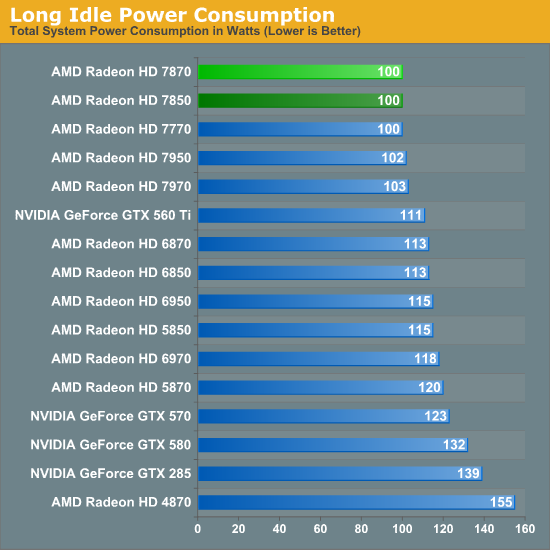
Long idle power consumption is virtually identical with the rest of the Southern Islands cards thanks to AMD’s ZeroCore Power technology. The next closest card is the GTX 560 Ti, and that’s at nearly 10W higher.
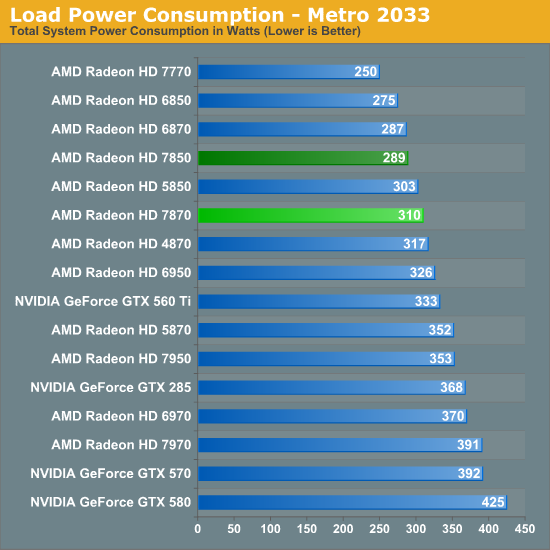
Moving on to load power testing, we have Metro 2033. Load power consumption here is about where you’d expect it to be, with the 7800 setups drawing more at the wall than the 6800 setups, but less than the 7900 and 6900 series. This is largely a consequence of performance, as the higher rendering performance of the 7800 series versus the 6800 series drives up CPU power consumption in order to generate more frames.
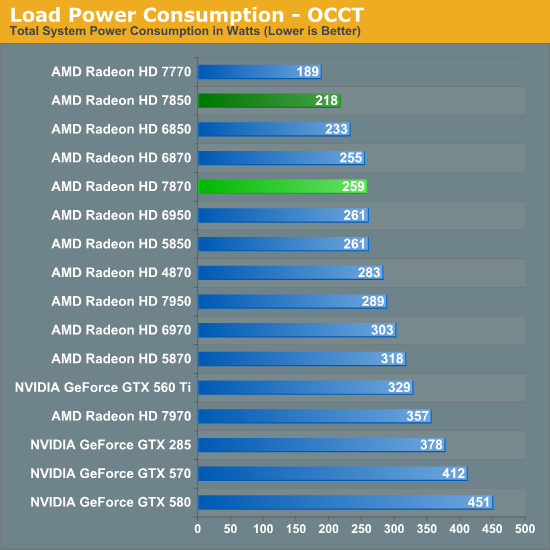
OCCT on the other hand gives us a more purified look at power consumption, and as you’d expect for 28nm it looks good. The 7870 ends up drawing only a few more watts at the wall compared to the 6870, showcasing the fact that the 7800 series is a drop-in replacement for the 6800 series from a power consumption perspective. The 7850 looks even better, capping out at 15W below the 6850, most likely as a result of PowerTune keeping the card firmly at 150W. Though it’s interesting to note that the measurements at the wall don’t perfectly align with the differences in PowerTune limits, with the 7850 drawing 30W more than the 7770 at the wall compared to a 50W PT difference, while the 7950 draws 30W more at the wall over the 7870 even though there’s only supposed to be a 10W PT difference.
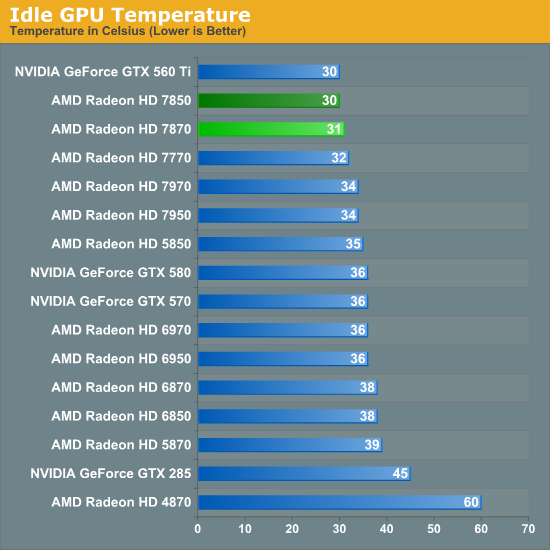
AMD’s latest generation blowers do quite well with idle temperatures and we can see it here. At 30C for the 7850 it’s every bit as cool as the GTX 560 Ti, while the entire 7800 series is around 5-8C cooler than the 6900.
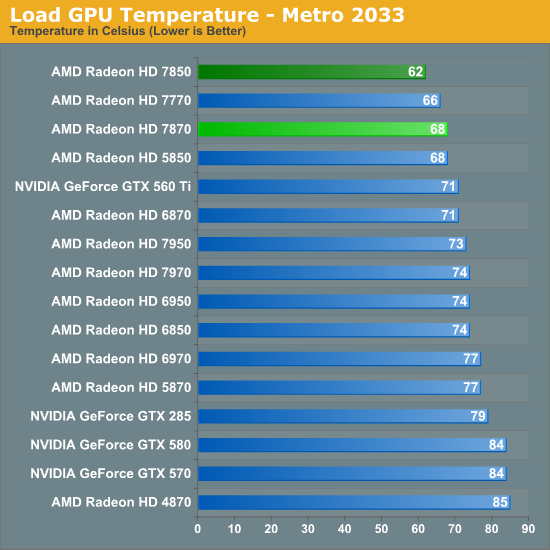
Under load, Metro temperatures are also quite good. At 62C the 7850 is the coolest card in this performance class, but keep in mind that it’s basically using an oversized cooler; retail cards will be open air coolers with much different characteristics. Otherwise at 68C the 7870 is still among the coolest cards, coming ahead of even the historically cool GTX 560 Ti, never mind the much hotter 6900 series.

Load temperatures climb under OCCT, but again the 7800 series is among the coolest temperatures we see. Here we see the 7870 peak at 73C, whereas its last generation counterpart would be at 80C and the GTX 570 at a toasty 87C.
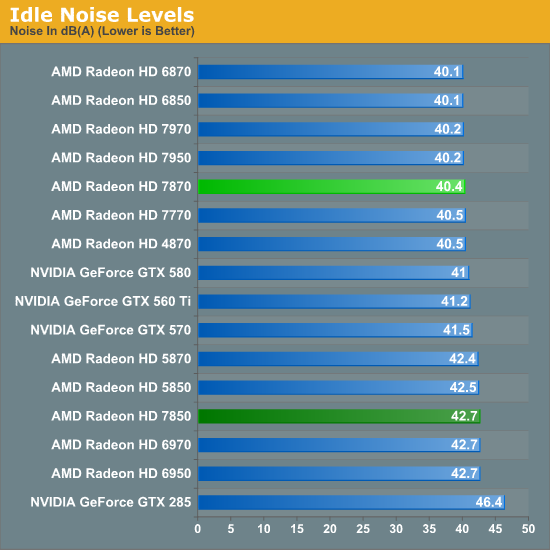
Moving on to noise testing, there are no major surprises at idle, with the 7870 hugging 40db. For whatever reason the 7850’s minimum fan state is roughly 200RPM higher than the 7870’s, but since no one will be using this cooler it’s not a significant result.
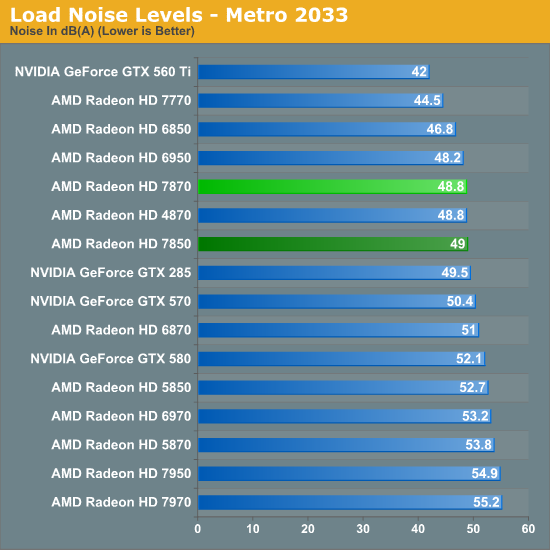
Consistent with AMD’s other 7000 series cards, we’re once again seeing the consequences of AMD’s aggressive cooling policies coupled with the use of a blower. At 48.8dB the 7870 is still quieter than the blower-based 6870, but it’s significantly louder than the open air cooled GTX 560 Ti, even though the latter consumes far more power and generates far more heat. This doesn’t make the use of a blower the wrong choice, but combined with aggressive cooling policies it does hurt AMD. The GTX 570, in spite of using much more power than the 7870, is only less than 2dB louder even though it too uses a blower.

Last, but not least we have our OCCT noise results. Unlike Metro the 7800 series does better on a relative basis here, but this is mostly because NVIDIA doesn’t have a power throttling system quite like PowerTune. At 51.9dB the 7870 is not the quietest card, but it still manages to beat the 6970 and the PowerTune-less 6870.
All things considered there are no great surprises here on a relative basis, as the 7800 series performs like we’d expect for a blower based sub-200W video card. Due to TSMC's 28nm process AMD greatly improves on their performance/power and performance/noise ratios with the 7800 series compared to the 6800 and 6900 series, while for their power class the 7800 series is slightly ahead of the pack on both power consumption and noise.
With that said, keep in mind that since most of AMD’s partners will be using open air coolers these results won’t be applicable to most retail cards. So for the temp/noise characteristics of retail cards you’ll want to look at individual card reviews when those start appearing later this month. This is particularly true for the 7950, where all of the retail cards will be using a different design than our sample.










173 Comments
View All Comments
ET - Monday, March 5, 2012 - link
I agree it's kind of disappointing. Even a 5750 was a good improvement over a 3870, and here there's nothing approaching this kind of performance benefit over the 5870 from these. Though I think part of it is that the 5870 still holds up well in many games, as these benchmarks show.Kjella - Monday, March 5, 2012 - link
I don't think it's that terrible... the 7870 fits pretty much the exact same power envelope as the 5850 and is starting to be a pretty solid performance upgrade. Yes it's a $350 card but inflation adjusted the $279 (pre-hike) 5850 is nearing $300 in 2012 dollars. A good deal and a good cooler (the reference cooler on the 5850 works, but is hardly quiet) and they may get a sale. Just waiting for Ivy Bridge, if nVidia hasn't shown a stunning Kepler by then I think the 7870 is it.Death666Angel - Tuesday, March 6, 2012 - link
Average increase of 40% in performance and you are comparing a high-end graphics card to a mid-range graphics card.DominionSeraph - Monday, March 5, 2012 - link
So, AMD discontinued the $250 6950 and $350 6970 to give us... a $250 6950 and $350 6970.Not exactly impressed.
Looks like it will be up to Nvidia to save us, just as they saved us from the price-gouged 5000 series with aggressive release price of the GTX 460 with price drops on the GTX 470. (That one action set the pricing scheme throughout the 6000/500 series)
CloudFire - Monday, March 5, 2012 - link
I'm not upgrading this cycle but I do wish to see Kepler out sooner to drive down prices. This is business and AMD has a few months of no competition so they are going to do all they can to reap massive profits.Nvidia isn't going to save you, they would do the same thing if they were in AMD's position. Remember nearly 5 years back with the 8800GTX going for 500+ for over a year? Yea......
DominionSeraph - Tuesday, March 6, 2012 - link
A halo product with no competition is beside the point. We're talking about the 7800 series which sits right in a range where there are competing products, and AMD is pricing it to suck you dry.The fact is that the 7000 series is not undercutting the 500 series the way Nvidia undercut the 5000 series. A $250 7850 vs a $270 + free Batman Arkham City GTX 560 Ti 448 Cores is about equal price/performance (maybe a tad in the favor of Nvidia). Contrast this to the GTX 460 being released at $200 when the 5770 was $180. The GTX 460 blew the doors off the 5770 and instantly said the appropriate price for that card is ~$130. A few months later we were seeing $110 5770's and $150 GTX 460's, and that's where we've been at ever since.
AMD refuses to aggressively compete with Nvidia. They simply slot their products into Nvidia's pricing structure. So prices only change when Nvidia drops theirs and AMD is forced to follow. This means that we, the consumers, are dependent on Nvidia to save us, because AMD sure as hell won't.
Exodite - Tuesday, March 6, 2012 - link
Not really a valid point of comparison though.Looking through several reviews of the 7800-series the 7850 lies closer to a 570 than a 560 Ti most of the time, while offering more and better in every possible category.
Sure, the 7850 isn't on the market yet but assuming the ~250 USD pricing holds true I couldn't possibly recommend a 560 Ti, or even 448 core version, over the 7850 with a straight face.
It could still be cheaper, sure, but it's nowhere near the pricing disaster the 7900 and 7700 series are.
To my mind the 7800 series were the ones to wait for.
Granted, with a 6950 myself I won't be upgrading until the 8k-series at the earliest. Unless Kepler turns out truly amazing, and brings triple display functionality on a single card.
tipoo - Monday, March 5, 2012 - link
If I recall Nvidia hasn't really under-priced AMD in recent memory, they've always tried x more performance sold for >x price.ET - Monday, March 5, 2012 - link
"AMD discontinued the $250 6950 and $350 6970 to give us... a $250 6950 and $350 6970."When you put it this way, it's quite a likeable upgrade actually. Slight boost in performance, lower power and better thermals, upgraded features, all for the same price. What's not to like?
chizow - Monday, March 5, 2012 - link
What's not to like is it took them 16 months to put out a greener refresh sidegrade.